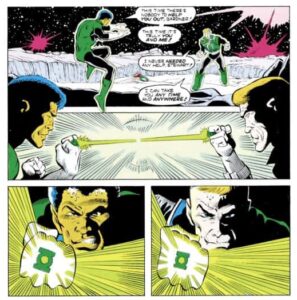***Contains Spoilers***
The Pre-Crisis Green Lantern comics are a wild ride through the cosmic and personal drama of the Corps. During this era, we see Hal Jordan quitting the Green Lantern Corps to pursue his romance with Carol Ferris, only for her to later become the villainous Star Sapphire. John Stewart takes over as Earth’s Green Lantern, and the story escalates into a sprawling narrative that leads directly into Crisis on Infinite Earths. The emotional stakes, sci-fi action, and the evolving mythos of the Green Lanterns all come into play here, with Hal, John, Guy Gardner, and others clashing in a battle for their identities and ideals. While the groundwork for modern Green Lantern stories is evident, the execution sometimes feels dated and uneven.
What I found impactful were the bold decisions in character development. John Stewart’s introduction as the primary Green Lantern is handled with confidence; he steps up immediately and even reveals his identity publicly, a sharp contrast to Hal’s secretive, more self-absorbed approach. I loved seeing John’s relationship with Katma Tui, as it added emotional depth and showcased the personal cost of wielding a power ring. Hal’s visits to a damaged Guy Gardner was striking, too, especially as they highlight Hal’s guilt and humanity. And even though Carol’s arc as Star Sapphire is problematic by today’s standards, the history of the Star Sapphire entity being tied to the Zamarons adds fascinating layers to her character.

However, there’s a lot I didn’t enjoy. Hal’s characterization throughout this run is frustrating. His hot-and-cold relationship with Carol feels less like romantic tension and more like poor writing—their dynamic has no consistent logic. The decision to have Hal quit being a Green Lantern just to regret it later undermines his journey. And while John is technically the lead Green Lantern during Crisis on Infinite Earths, the focus remains squarely on Hal, almost as if the writers couldn’t fully let go of their original hero. It feels unfair to John, who deserved more spotlight, especially after stepping into the role so effectively. Meanwhile, Guy Gardner’s resurrection and immediate antagonism toward Hal and John feels rushed and contrived, leading to a final act that is chaotic but emotionally hollow. The introduction of a rogue army of villains and Guy’s fight with the Corps is meant to feel climactic but lacks the emotional payoff it seems to aim for.
In conclusion, I can appreciate the ambition of this Pre-Crisis Green Lantern era. It attempts to balance complex interpersonal drama with the sprawling cosmic mythology of the Corps, and it lays the foundation for many of the concepts we love today. But the execution falters—character dynamics are inconsistent, and the story leans too heavily on Hal Jordan even when others are more deserving of the spotlight. While I liked the origins and history explored in this era, the storytelling sometimes felt like a chore to get through. I’d give this period two stars out of five—it’s historically significant, but not one I’m eager to revisit.
Feature Image Green Lantern vol.2 #197 Cover Art By Joe Staton & Bruce Patterson
Keep NewToComics.com running with a donation or shopping with through our affiliates—your support helps maintain the site and continue guiding new readers into the world of comics!


